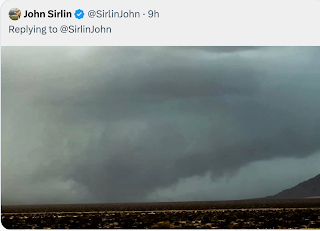How Good Were the Derecho Forecasts?
The derecho was still in progress when I heard the first grumbling about the forecast. So, I asked Greg Carbin of the NWS's Storm Prediction Center to run a forecast validation. I told him I would post it on the blog.
Keep in mind that forecasts presented on the blog were expressed as probabilities so that people could see the areas at highest risk. Meteorologists validate that against a "hindcast" -- a map of what would have been the perfect probabilities based on the reports of what actually occurred.
Wednesday
The thick lines are the forecast, the thin lines are the "perfect" probabilities and the blue are the wind reports. The placement is excellent. The density of reports doesn't quite reach the 60% level but, given the difficulty of forecasting derechoes, the forecast is quite good.
Thursday
From the beginning, this was forecast to be a two-day event. The 11:30am CDT forecast yesterday had to be moved south compared to earlier forecasts. That said, the forecast is excellent. If anything, it is a bit of an underforecast because the 60% threshold was reached.
One of the things that sets meteorology apart is that we validate our forecasts with a goal of always trying to improve.
Keep in mind that forecasts presented on the blog were expressed as probabilities so that people could see the areas at highest risk. Meteorologists validate that against a "hindcast" -- a map of what would have been the perfect probabilities based on the reports of what actually occurred.
Wednesday
 |
| click to enlarge |
Thursday
From the beginning, this was forecast to be a two-day event. The 11:30am CDT forecast yesterday had to be moved south compared to earlier forecasts. That said, the forecast is excellent. If anything, it is a bit of an underforecast because the 60% threshold was reached.
One of the things that sets meteorology apart is that we validate our forecasts with a goal of always trying to improve.





The prediction of the probability of severe weather was excellent, and that is truly cause for celebration. However, I have two problems:
ReplyDelete1)We should not be forecasting "derechos" as such. It is as appropriate to forecast a derecho as it is to explicitly forecast an EF5 tornado. Both are post event classifications of a more general phenomena (MCS's and tornadoes respectively).
2)Additionally, there is (understandably) considerable public ignorance regarding what the term derecho even means, with a vast number of residents across the Ohio Valley and the Mid-Atlantic making a fear-based association with the term as a result of the 29Jun12 event.
As a result, by forecasting a derecho rather than the actual impacts an anticipated MCS is anticipated to produce, one exits the legitimate bounds of our current meteorological abilities and and concurrently uses language that is more likely to produce panic than preparedness. Such choices can not lead to a sustained sucess in warning the public.
Better would be to forecast the expectation for long-lived organized thunderstorms that are expected to produce damaging wind gusts along its path frequently near or in excess of 60 mph. Such is the meteorologically honest forecast which speaks to the impacts expected and avoids to the greatest extent possible inciting fear, and such is the historically consistent with our goal of properly preparing and warning the public of potential and impending hazardous weather.
---
As a seperate but yet still somewhat related note, I notice the SPC has elected to call this a "low-end derecho" (
https://www.facebook.com/photo.php?fbid=674249119258721&set=a.252124794804491.85779.248179758532328&type=1). Really? In the same way an EF3 or or even an EF4 could be called a low-end EF5? What differenciates a derecho from a "low-end derecho"? (http://www.spc.noaa.gov/misc/AbtDerechos/derechofacts.htm)
I see now that starting with the 1535z 3E Dorton (Pike, KY) / 1635z Buchannon (Upshur, WV) obs, and continuing through the 0000z Jennettes Pier (OBX Dare, NC) ob, there is an MCS path length of roughly 350 miles, with all but two obs, the first in KY and one of the last at a water exposure weather flow station on the CBBT's 3rd island), remaining under 75 mph. (Typical measured winds were in the 60-65 mph range).
DeleteSo, I stand corrected that eastern KY, WV, VA, NC, DC, MD, DE, and far southern NJ) were (in appropriate hindsight) were indeed impacted by a serial derecho, that did not reach the moderate to high strength criteria set by Johns and Hirt.
This comment has been removed by the author.
ReplyDeleteMike,
ReplyDeleteThe NWS Central Illinois office has posted a very informative piece explaining why capping prevented forecast severe thunderstorms from developing in central Illinois. To see it go to www.crh.noaa.gov/ilx and click on the link "Wednesday's Forecasted Severe Weather -- What Happened?" It doesn't use the word "cap" but it explains what a cap is in layman's terms. It also uses the interesting analogy of a barbershop quartet in which the voices never quite harmonize to explain why the forecast storms didn't happen.
Elaine